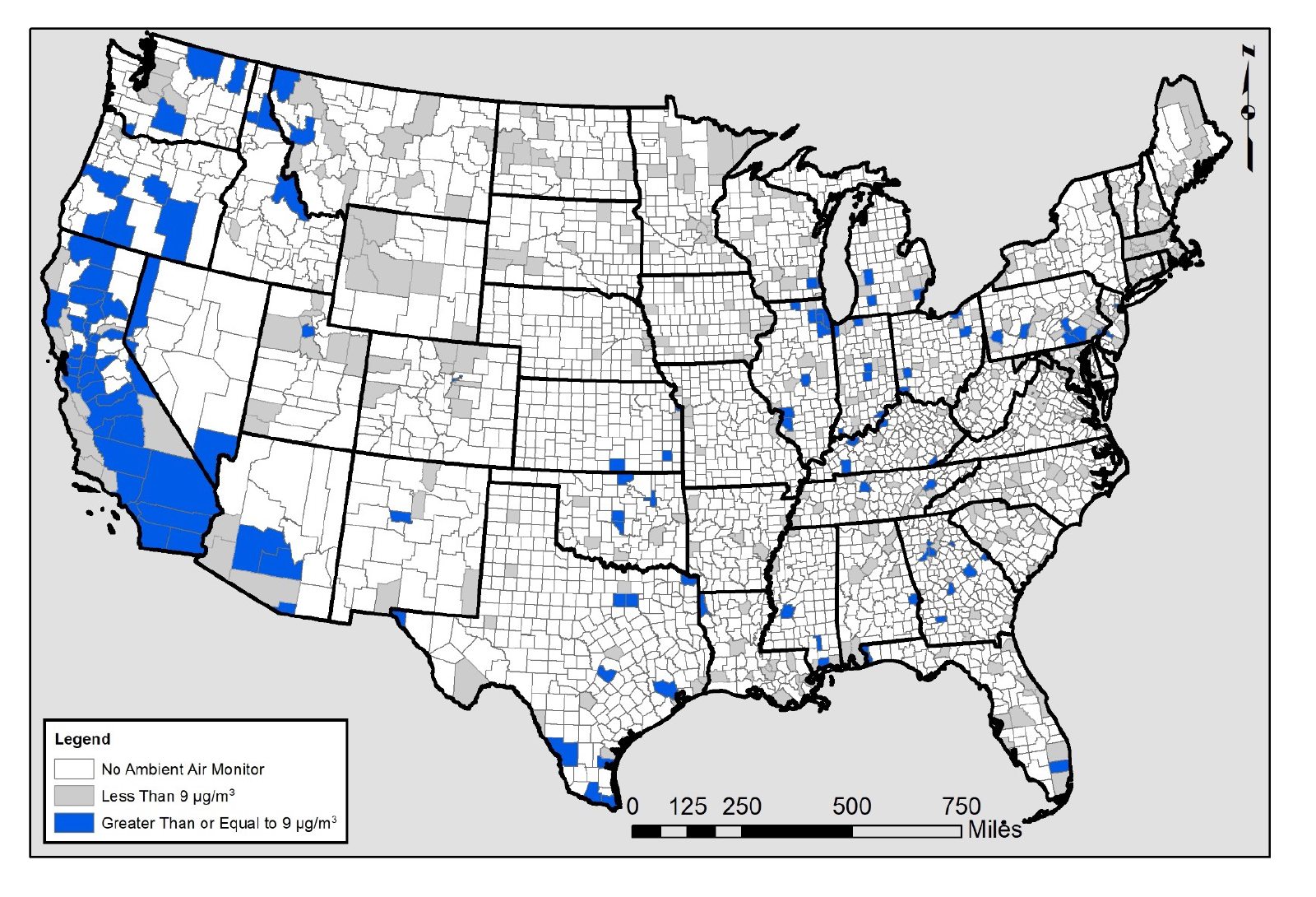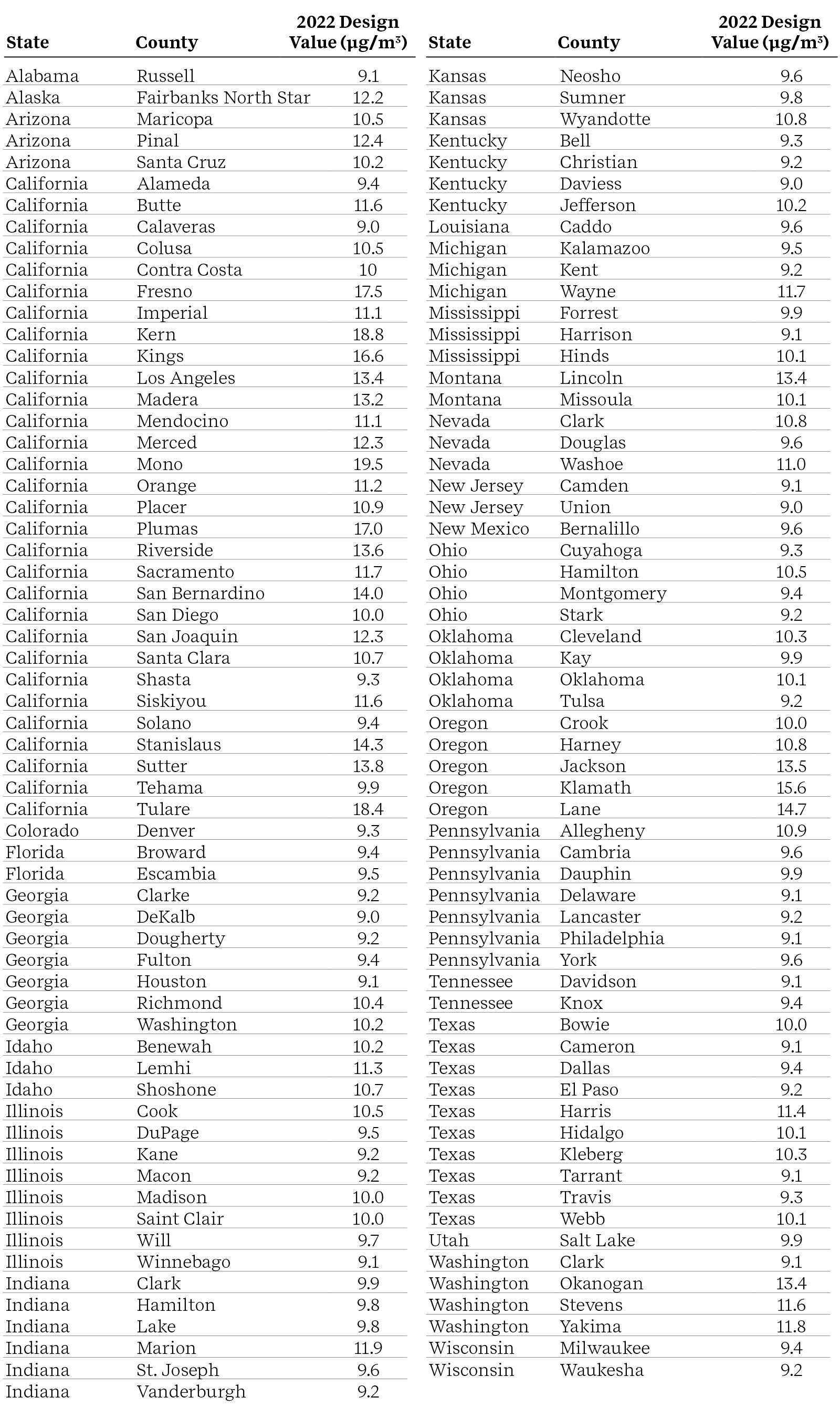On February 7, 2024, the U.S. Environmental Protection Agency (EPA) lowered the level of the annual National Ambient Air Quality Standard (NAAQS) for fine particulates (PM2.5) from 12.0 to 9.0 micrograms per cubic meter (μg/m3).
In nonattainment areas:
- Stricter PM2.5 emission limits, which could require additional, costly controls for existing units; new and modified units would require expensive Lowest Achievable Emission Rate (LAER) controls. In either case, the return on capital projects is likely to suffer and some may no longer be viable.
- Additionally, the need for emission offsets for new and modified sources may prove prohibitive in the near term due to lack of available offsets.
In attainment areas:
- Reduced headroom (i.e., the difference between revised NAAQS and current background levels), making it difficult to demonstrate compliance with the revised NAAQS via air quality modeling.
- Potential delays in obtaining permits due to additional complex analysis and compliance measures (growth-oriented capital expenditures could be delayed).
The Clean Air Act requires EPA to review the NAAQS every five years to determine whether they should be revised or retained. The Particulate Matter (PM) NAAQS were last revised in 2012. Though the EPA lowered the level of the annual NAAQS for PM2.5, the other PM NAAQS standards remain the same. The EPA has retained the current primary 24-hour PM2.5 standard and the primary 24-hour PM10 standard. The EPA did not change the secondary 24-hour PM2.5 standard, secondary annual PM2.5 standard, or the secondary 24-hour PM10 standard. The EPA finalized revisions to other key aspects related to the PM NAAQS, including revisions to the PM ambient monitoring requirements.
The final rule does not make any PM2.5 NAAQS attainment/nonattainment designations. Rather, the revised annual PM2.5 NAAQS will prompt the designation process that the EPA will require states to undergo based on current PM2.5 monitoring data. This process could take up to two years. Areas not in attainment with the lower PM2.5 NAAQS will be designated nonattainment, which will trigger nonattainment new source review (NSR) permitting requirements. These requirements would likely contain more stringent LAER controls and involve purchasing costly PM2.5 emission reduction credits/offsets.
Additional major implications of the rule include:
- Prevention of Significant Deterioration (PSD) will apply with respect to the revised 9 μg/m3 NAAQS in all areas of the U.S. designated attainment upon the revised NAAQS’s effective date (60 days after publication in the Federal Register).
- The EPA will release an updated annual PM2.5 Significant Impact Level (SIL) before the revised NAAQS effective date. Given the 25% reduction in the annual NAAQS, a similar reduction in the associated SIL will make it more difficult to demonstrate that your project’s impacts are insignificant.
- Permit applicants that received their final PSD permit before the revised standard’s effective date will not be required to demonstrate compliance with the new NAAQS for the project authorized by the final permit. Facility owners with PSD permits still in process will need to demonstrate compliance with the revised standard, potentially including evaluating whether additional air pollution emissions reductions are needed.
- For any areas that are newly designated as nonattainment for the revised NAAQS, nonattainment NSR will apply upon the effective date of nonattainment designations. During the designation process, the EPA promises to work to ensure there is an efficient, user-friendly pathway for excluding data impacted by prescribed fire and wildfire smoke.
- On February 8, 2024, the EPA released a memorandum and other data providing the Agency’s expectations on the process and schedule for designating areas under the revised standard.
There are currently nine locations in the U.S. under nonattainment or maintenance area status for the previous annual PM2.5 standard of 12 μg/m3. It is currently possible to estimate the expected increase in nonattainment areas. Monitoring data design values for 2020-2022 of all PM2.5 monitors in the U.S. reveals that there will be at least ten times the number of monitors with design values above the revised standard of 9 μg/m3. The figure in the attachment below illustrates the continental U.S. counties with current monitoring design values at or above the revised annual NAAQS of 9 μg/m3. In addition, the table in the attachment summarizes the calculated 2022 design value for each state/county that is at or above 9 μg/m3, illustrating cz of how many areas will be affected.
How ERM can help?
ERM is equipped to provide tailored solutions to help navigate the challenges associated with the lower annual PM2.5 NAAQS. This is especially important if you are planning capital projects for your facilities. You may want to proactively address the items listed below to mitigate risk of delays and minimize escalation of capital expenditures. ERM can help develop a compliance strategy through the application of the following approaches:
• Background Concentration Assessment - ERM can assess current PM2.5 monitoring measurements made near your facilities to identify PM2.5 headroom for future projects or to provide a heads-up that the facility may be located in an annual PM2.5 nonattainment area. ERM can also use the EPA’s proposed new framework for characterizing background concentrations in cumulative air impact modeling analysis. Further, ERM can leverage EPA guidance on handling and accounting for exceptional events, such as wildfire smoke, to mitigate impacts on monitors used to characterize background concentrations.
• Proactive PM2.5 Monitoring – ERM can implement a robust air quality monitoring program to provide a facility-specific background PM2.5 concentration. For permitted facilities located far from the existing monitors in the EPA ambient monitoring network, a facility-specific monitoring program may result in lower background concentrations which can be used in NAAQS modeling demonstrations (a requirement of PSD permitting). The ERM monitoring team has PSD-quality PM2.5 monitors that are ready to deploy.
• Refining conservative emission factors – ERM can review and refine outdated or conservative emission factors to estimate emissions more accurately.
• Revisiting generous permit limits – For sources with actual emissions consistently below permit limits, ERM can help develop lower permit limits to comply with the revised NAAQS while minimizing costly changes to equipment and operations.
• Refresh your PM2.5 air quality modeling – If there is a concern that your existing or proposed operations may indicate modeled noncompliance with the revised NAAQS, we can refresh your air quality modeling with revised emission estimates to identify issues and possible mitigations.
Our air quality specialists have performed permitting support for a diverse group of industrial and government clients in response to a wide variety of needs, and ERM’s expertise has been nationally recognized for our participation and performance in the fields of air monitoring, emissions control, and regulatory modeling. ERM is committed to providing air quality permitting support that provides the best representation of a given situation within established guidelines that withstand detailed review throughout the length of a project. Through this support we have been able to accelerate capital project schedules, to mitigate risk of delays, and help our clients minimize control and operating costs.
The following map and table present the counties in the United States where annual PM2.5 2022 design value concentrations are at or above the revised NAAQS of 9 μg/m3. There is one monitor of concern in Alaska that is listed in the following table of counties with 2022 design value at or above the revised annual PM2.5 NAAQS of 9 μg/m3.

Counties with 2022 Design Value at or above the Revised Annual PM2.5 NAAQS of 9 μg/m3

Data source: Air Quality Design Values | US EPA
ERM contacts
| David Shotts New York, NY ERM Global Air Quality Technical Community Lead +1 917 386 6902 david.shotts@erm.com |
Tom Wickstrom Philadelphia, PA ERM North America Air Quality Technical Community Lead +1 484 913 0453 tom.wickstrom@erm.com |
Doug Dziubla Chicago, IL Air Quality Monitoring +1 847 258 8914 doug.dziubla@erm.com |
| Olga Samani Boston, MA Air Quality Modeling +1 617 646 7851 olga.samani@erm.com |
Dan Guido Indianapolis, IN Air Quality Modeling +1 317 249 4737 daniel.guido@erm.com |
Jeff Twaddle Nashville, TN Air Quality Major Source Permitting +1 615 656 4636 jeff.twaddle@erm.com |
| Anand Rathinasamy Houston, TX Air Quality Major Source Permitting +1 832 924 5402 anand.rathinsamy@erm.com |
Jim Dill Irvine, CA Air Quality Compliance +1 949 623 4709 jim.dill@erm.com |

